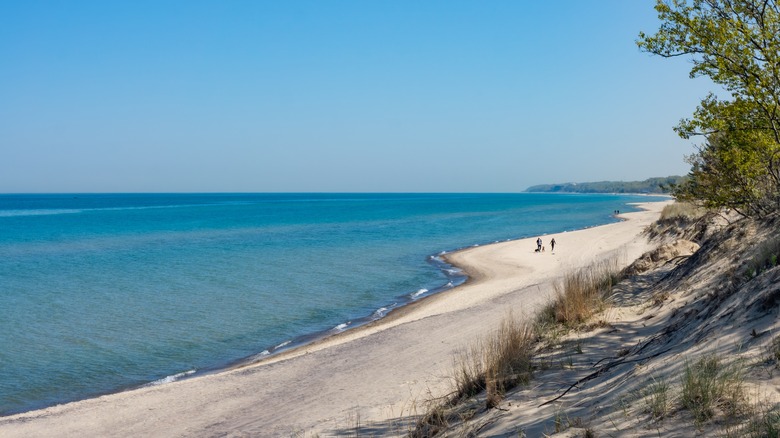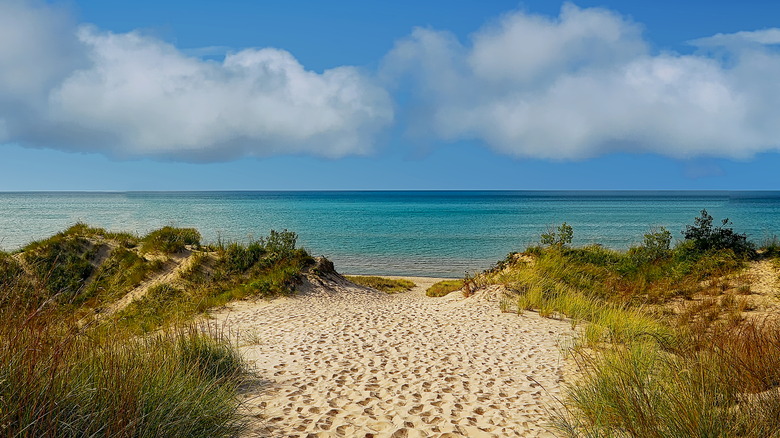This Lakeside Midwest National Park Is The Perfect Escape For Outdoor Enthusiasts
Sandy beaches and sand dunes might not be the first thing that comes to mind when thinking of a park in the Midwest, but that's exactly what Indiana Dunes National Park has to offer. At the Southern shore of Lake Michigan, this park presents a unique combination of dunes, beaches, wetlands, woodlands, and prairies. Spanning 15,000 acres, Indiana Dunes is one of the smallest national parks in the United States. However, what it lacks in size, it more than makes up for in natural beauty and recreational opportunities.
The range of activities available at Indiana Dunes National Park is impressive, with plenty of opportunity for exploring bike trails like the Calumet Bike Trail or hiking any of the 15 trail systems through the dunes. Cross-country skiing and snowshoeing are even popular at the park during winter. The Dunes Learning Center also hosts educational programs and events for adults and families traveling with children interested in the outdoors.
But perhaps the most iconic activity at Indiana Dunes is climbing the towering sand dunes that give the park its name. With dunes up to 200 feet high formed by ancient glaciers and winds blowing off Lake Michigan, hiking to the top offers stunning views of the surrounding Indiana landscape. The Calumet Dunes trail even connects to a trail system to the park's largest "living" dune, Mount Baldy, at 126 feet above Lake Michigan.
The park's sandy beaches by Lake Michigan
Indiana Dunes National Park's most expansive feature is its pristine sandy beaches. With 15 miles of Lake Michigan shoreline, visitors are treated to golden sands and clear, refreshing waters. The park's proximity to Lake Michigan makes Indiana Dunes National Park a popular destination for water activities like paddling and rafting. Because of the size and currents of Lake Michigan, paddling past the breakers is only recommended for experienced paddlers with proper gear.
Kemil Beach and Dunbar Beach are popular spots for swimming, sunbathing, and even spotting a few historic homes. But if you're looking for a more secluded beach experience, head to Central Beach, where you can drop your cooler in the sand and relax away from the crowds. For those seeking more of an adventure, there are opportunities for kayaking along the Kankakee River National Water Trail, the Lake Michigan Water Trail, and other waterways in the park.
In addition to its recreational activities, the park's beaches have diverse ecosystems that support many plant and animal species. Ranked fourth for biological diversity, Indiana Dunes National Park has thousands of unique plants like the federally endangered Pitcher's Thistle. This endangered, dune-dwelling plant grows along the shores of Lake Michigan and is an integral part of the park's ecosystem.
Lakeside wildlife spotting and hiking opportunities
For those who love to explore on foot, Indiana Dunes National Park offers an extensive network of hiking and nature trails. From short, family-friendly walks to more challenging treks, visitors can enjoy hiking through the park's diverse landscapes, with over 50 miles of trails to explore. The Cowles Bog Trail, for example, is a moderately difficult trail that takes you through diverse landscapes, from wetlands to forests, and over steep, sandy terrain.
One of the most popular trails is the 3 Dune Challenge, a strenuous hike that takes visitors up and down the three tallest sand dunes in the park. Mount Tom, the tallest dune standing at 192 feet, Mount Holden, and Mount Jackson are all a part of the 3 Dune Challenge. The trail runs a mere 1.5 miles but pushes hikers to tackle over 550 vertical feet of terrain. Albeit challenging, the trail provides incredible opportunities to spot various wildlife.
Today, the park's trails, dunes, and other wetland habitats create a sanctuary for various plant and animal species. Indiana Dunes is home to wildlife like the endangered Karner Blue butterfly, over 350 species of birds, 23 reptile species, and over 40 different mammals. Fishing enthusiasts can also grab an Indiana Fishing License and stamp and cast a line into Lake Michigan and catch a variety of species, including trout and salmon.


